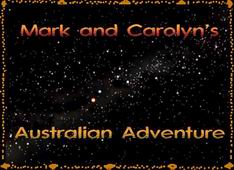
NARRABRI
|
Our last astronomy-related visit was to the Australia Telescope National Facility's Compact Array at Narrabri, a short drive from Coonabarabran. We were met there once again by John Smith, the same fine fellow who showed us around Parkes a couple of days earlier. He actually works at both Visitor Centres, dividing his time between the two.
|
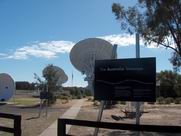
|
We arrived at the Australia Telescope Compact Array in the late morning, and once again splitting up into two tour groups so that John Smith could take us around more easily. Those of us who were in the first group donned our hard hats and headed out for the dishes; we're getting pretty experienced at this routine!
 Australia Telescope Compact Array Australia Telescope Compact Array
|
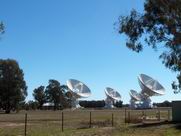
|
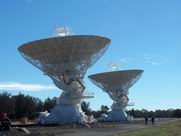
|
There are six 22-meter telescopes in the array and when we were there they were arranged in a fairly tight grouping.
The dishes are moved around on railroad tracks.
|
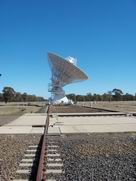
|
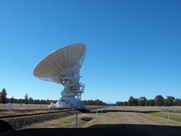
|
The day we were at the array, the astronomers were doing some calibration work and observing at least one cold, compact dark gas cloud called IRDC2. These give off distinctive signals that allow them to be detected against the bright background of the Milky Way.
We walked out near the central antenna and John explained some of the maintenance and use rules that astronomers follow.
|

|
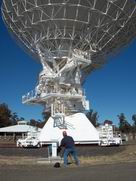
|
We stepped away for a little while (with John's permission) to get some all-sky images of the array. Mark took several, including a nice one with the central antenna nicely front and center.
|
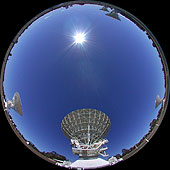
|
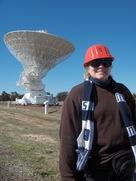
|
It was really a thrill to be at yet another radio astronomy installation!
And our pictures look a lot like those we took at the Very Large Array in New Mexico in 2002. They're both basically the same design, though the VLA has more dishes!
|
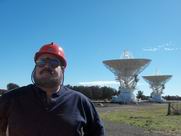
|

|
When our group finished the tour we headed back to the Visitors Centre and took in some of the exhibits. The facility has a nice set of outdoor displays, like the whisper dishes at right. If you stand at one dish and whisper into it, it is focused so well that someone standing at the other dish will hear what you said without any problems.
|
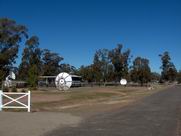
|
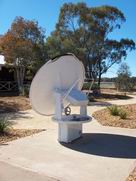
|
They also have a little dish that is "live", meaning that it's wired pick up radio sources, and convert the signals to audio. It works best with the Sun and Jupiter.
Mark and some of the group took turns pointing it at the Sun and listening to the signal it picked up. Although most signals picked up by radio telescopes are not ones you can hear, this display dish had been specially built to simulate what one would hear if we had ears that could detect signals at radio telescope wavelengths.
|
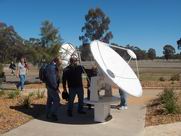
|
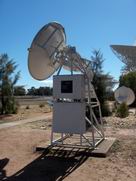
|
There's also a small radio telescope that was once used by CSIRO (the parent organization of the ATNF) to monitor radio waves from the Sun for a couple of decades. It is now part of the outdoor display.
|
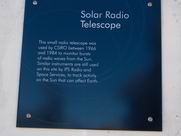
|

|
Carolyn thought this exhibit about wavelengths was rather clever. It shows how wavelengths go from short to long and the panels talk about how astronomers use wavelengths of light (including radio) to study objects in the universe. (The clickable image opens up a larger panorama. You may have zoom in and use your scroll bar so you can see the whole picture.) |

|
When it was our group's turn we headed over to the Culgoora Solar Observatory, run by the Australian Government's Ionosphere Prediction Service, which is also located at this site. It consists of one building and several instruments, all run by one lone government scientist.
|
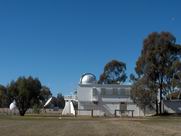
|
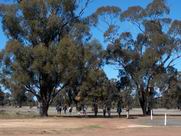
|
It was a short walk through a field that looked like it might spend time as a lakebed when it rains in this neck of the woods. A small sign pointed us toward the building.
|
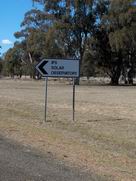
|
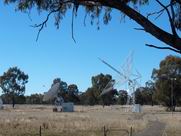
|
Outside, we looked at the field instruments used by the IPS scientist.
Inside, we got a tour of the coronagraph, which is fed by a telescope that remains pointed at the Sun all day.
|

|
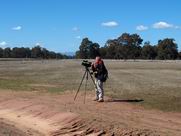
|
Afterward, we went back to a small field near the Visitors Centre for some last-ditch photography. While Shoichi Itoh once again set up his hi-def video camera, Carolyn did a little lakebed geology.
Recent rain runoff made for some distinctly familiar-looking landforms (albeit in miniature).
|
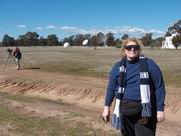
|
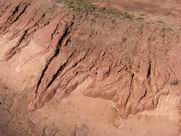
|
Carolyn thought these little runoff gullies looked a lot like those seen on Mars from Mars Global Surveyor. Of course, Mars doesn't have green vegetation, but the point here is that the effects of runoff are the same, whether it's in a dry wash in Australia or in a crater on Mars.
Like any good geologist, she put a familiar object in the scene (in this case her wrist watch, about three inches across) for a sense of scale.
|
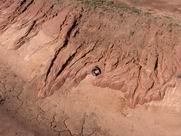
|
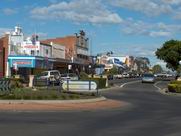
|
We concluded our last astronomy tour and headed back to the town of Narrabri to find some lunch, and check in at the Nandewar Motor Inn.
 Narrabri Narrabri
|
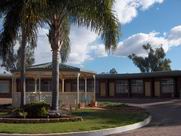
|
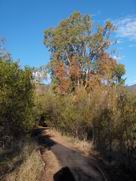
|
After lunch our bus driver George suggested that we take a run up to Mt. Kaputar National Park and the Sawn Rocks formation. Ready for some nature sightseeing, we drove out and took a short hike (less than a mile) to this unique volcanic rock formation.
Along the way Carolyn noticed a pine tree that seemed to be pointing at the Moon.
|
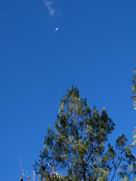
|
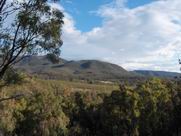
|
Sawn Rocks lies at the end of a lush valley.
Your first glimpse of it comes through the trees after about 10 minutes of walking.
 Sawn Rocks Sawn Rocks
|
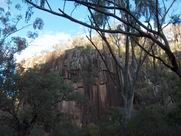
|
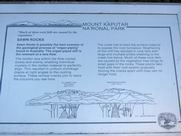
|
Along the path the park rangers have put up informational plaques to explain the volcanic origins of the Sawn Rocks and other formations in the park. As you can read, much of the rock falls have been caused by vegetation growing in the crevices.
When we arrived at the base of the rocks, Aase was the first to get her picture taken up against the rocks.
|
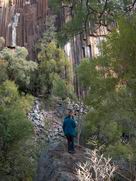
|
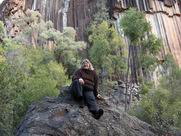
|
Carolyn clambered up the rocks and Volker Roehrs took her picture.
Then, Mark showed up and we took his picture, too.
|
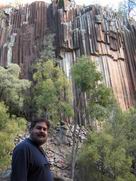
|
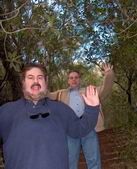
|
Carolyn surprised both Mark and Volker by stopping them in mid-path and taking their picture!
The rocks are pretty amazing. They stretch up from the valley floor several hundred meters and show a variety of colors from orange to brown to pink, depending on lighting conditions. Lush foliage clings to the rocks and clusters at the base of the pipes.
|
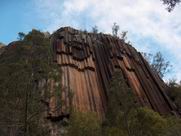
|
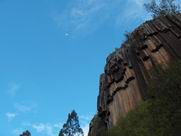
|
Carolyn just couldn't resist another Moon shot.
There's a little rock garden surrounded by trees and bushes at the bottom of the cliffs. A small stream meanders through, and over time it is cutting into the rock bed.
|
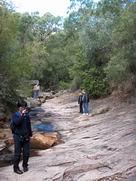
|
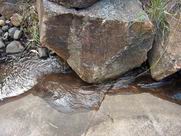
|
The base area is littered with chunks of the "pipes" that have fallen, making a multi-level stream bed.
The sky reflecting in the water gave a nice accent against the sandy-colored rock.
|
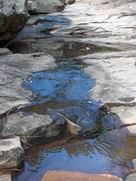
|
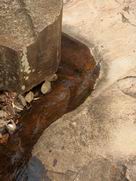
|
As the stream winds around rocks, it ends up pooling in several places.
Collections of smooth stones at the bottoms of the pond give it a placid appearance.
|
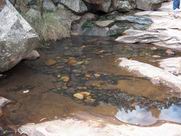
|
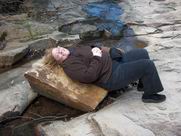
|
At one point Carolyn laid down to look up at the rocks from a different perspective.
Everybody wanted to take her picture; even Mark got into the act.
|
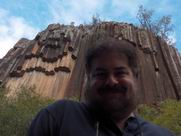
|
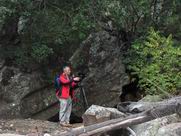
|
As always, Shoichi Itoh had set up his hi-def camera. We went over to see what he'd found and marveled at a little pool that lay at the base of some columnar rocks, piled like logs by a fireplace. We named it "Sho's Zen Pool."
|
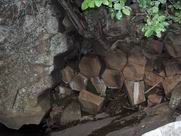
|
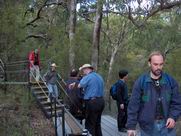
|
We spent about an hour and a half at Sawn Rocks, almost until sunset. We headed back up the trail (reluctantly) and when we got to the parking lot we were greeted by sunset behind the nearby mountains.
George got some pictures of it, while Torvald Hessel helped him keep his balance on the parking barrier.
|
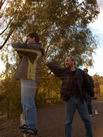
|
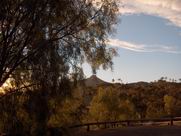
|
Sunset was magnificent and made a perfect backdrop to a wonderful afternoon, as we headed back to the Nandewar Motor Inn for our final tour dinner.
 Nandewar Motor Inn Nandewar Motor Inn
|
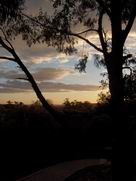
|
© Copyright 2006, Loch Ness Productions
Last update: 21 August 2006
|